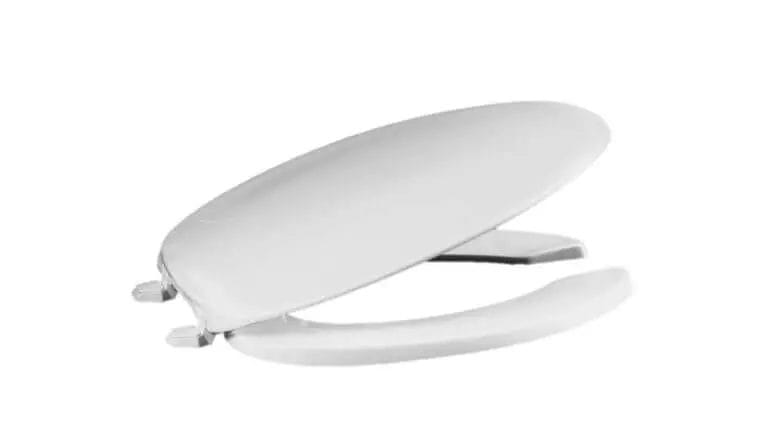If you’re looking for effective ways to clean a wood toilet seat, you’ve come to the right place. Cleaning a wood toilet seat requires a delicate touch to ensure its longevity and hygiene. In this guide, we will provide you with step-by-step instructions and useful tips on how to properly clean and maintain your wood toilet seat. Whether you’re dealing with stains, odors, or general grime, these methods will help you restore your wood toilet seat to its pristine condition. Keep reading to discover the best practices for keeping your wood toilet seat clean and fresh.

Natural Cleaning Solutions for Wood Toilet Seats
Wood toilet seats add a touch of elegance and warmth to any bathroom. However, cleaning them requires a gentle approach to avoid damaging the wood. If you prefer to use natural cleaning solutions, there are several effective options that can keep your wood toilet seat clean and well-maintained. In this section, we will explore some of the best natural cleaning solutions for wood toilet seats.1. Vinegar Solution
One of the most versatile natural cleaning agents is vinegar. It is effective in removing stains, eliminating odors, and disinfecting surfaces. To create a vinegar cleaning solution for your wood toilet seat, mix equal parts of distilled white vinegar and water in a spray bottle. Shake well to combine the ingredients. To clean your wood toilet seat, spray the vinegar solution onto a soft cloth or sponge. Gently wipe the seat, paying special attention to any stains or spots. Avoid using excessive moisture or applying too much pressure, as this can cause the wood to warp or lose its finish. After cleaning, rinse the cloth or sponge with clean water and wipe the seat again to remove any vinegar residue. Finally, dry the wood toilet seat thoroughly with a clean, soft cloth.2. Lemon Juice and Baking Soda Paste
The combination of lemon juice and baking soda creates a natural paste that is effective in removing stubborn stains from wood surfaces. Lemon juice acts as a natural bleach, while baking soda acts as a gentle abrasive. To make the paste, mix equal parts of lemon juice and baking soda in a small bowl. Stir until you achieve a thick, spreadable consistency. Apply the paste onto the stained areas of your wood toilet seat using a soft cloth or sponge. Gently rub the paste into the wood in circular motions, focusing on the stains. Allow the paste to sit on the stains for a few minutes. Afterward, rinse the cloth or sponge with clean water and wipe away the paste from the wood. Use a separate damp cloth to remove any residue. Finally, dry the seat thoroughly with a soft cloth.3. Castile Soap Solution
Castile soap is a natural, vegetable-based soap that is gentle on wood surfaces. It effectively cleans and removes dirt without causing damage or stripping away the wood’s natural oils. To create a castile soap solution, dilute a few drops of castile soap in a bowl of warm water. Mix well to create a soapy solution. Dip a soft cloth or sponge into the solution and gently scrub your wood toilet seat. Pay attention to any soiled areas or stains. Avoid using excessive moisture, as this can seep into the wood and cause damage. After cleaning, rinse the cloth or sponge with clean water and wipe away any remaining soap residue from the seat. Finally, dry the wood toilet seat thoroughly with a clean, soft cloth.4. Olive Oil Polish
In addition to cleaning, it is essential to maintain the luster and shine of your wood toilet seat. Olive oil can be used as a natural polish to restore and protect the wood’s finish. First, remove any dust or debris from the wood toilet seat using a soft cloth or duster. Then, apply a small amount of olive oil to a clean, soft cloth. Gently rub the oil onto the wood, ensuring even coverage. Allow the olive oil to penetrate the wood for a few minutes. This will help nourish and moisturize the wood, preventing it from drying out or cracking. Afterward, use a separate clean cloth to buff the wood toilet seat, removing any excess oil and enhancing its shine. Take caution not to use too much oil, as this can lead to a greasy surface. In summary, natural cleaning solutions can effectively maintain the cleanliness and appearance of your wood toilet seat. Vinegar solutions, lemon juice and baking soda paste, castile soap solutions, and olive oil polish are all great options to keep your wood toilet seat looking its best. Remember to always test any cleaning solution on a small, inconspicuous area of the seat before applying it to the entire surface. With proper care and regular cleaning, your wood toilet seat will continue to add a touch of natural beauty to your bathroom.
How to Remove Stains from a Wood Toilet Seat
Having a clean and stain-free toilet seat is essential for maintaining good hygiene in your bathroom. However, over time, wood toilet seats can develop stubborn stains that are not easy to remove. In this section, we will discuss effective methods to help you remove those unsightly stains from your wood toilet seat.

Materials You Will Need:
- Mild detergent
- Baking soda
- White vinegar
- Lemon juice
- Toothpaste
- Soft cloth or sponge
- Old toothbrush
Step-by-Step Guide:
Step 1: Prepare the Cleaning Solution
Begin by creating a cleaning solution using mild detergent and warm water. Mix a small amount of detergent with water in a bucket or bowl. Stir the mixture until the detergent is well-dissolved.
Step 2: Apply the Cleaning Solution
Dampen a soft cloth or sponge with the cleaning solution and gently scrub the stained areas on the wood toilet seat. Make sure to cover the entire stained surface and apply moderate pressure while scrubbing.
Step 3: Use Baking Soda Paste
If the stains persist, mix baking soda with a small amount of water to form a paste. Apply the paste to the stained areas and let it sit for about 15 minutes. Then, scrub the stains with a soft cloth or sponge.
Step 4: Try White Vinegar or Lemon Juice
If the baking soda paste does not fully remove the stains, you can try using white vinegar or lemon juice. Dip a cloth or sponge in either white vinegar or lemon juice and gently scrub the stained areas. Both white vinegar and lemon juice have natural acidic properties that can help break down stubborn stains.
Step 5: Use Toothpaste
Toothpaste can also be an effective stain remover for wood toilet seats. Apply a small amount of toothpaste directly onto the stains and scrub gently with an old toothbrush. Rinse the seat thoroughly with water afterward.
Step 6: Rinse and Dry
Once you have finished scrubbing the stains, rinse the wood toilet seat with clean water to remove any residue from the cleaning products. Use a dry cloth to pat the seat dry or allow it to air dry naturally.
Step 7: Regular Maintenance
To prevent future stains, it is important to practice regular maintenance for your wood toilet seat. Wipe it down regularly with a damp cloth and mild detergent to keep it clean and free from buildup.
Precautions:
- Avoid using harsh chemicals or abrasive cleaners as they can damage the wood surface of the toilet seat.
- Test any cleaning solution on a small, inconspicuous area of the seat before applying it to the entire stained surface.
- Always wear gloves and ensure proper ventilation when using cleaning products.
In summary, removing stains from a wood toilet seat requires a gentle yet effective approach. By following these steps and using the right cleaning materials, you can restore the cleanliness of your wood toilet seat and maintain a hygienic bathroom environment.

Preventative Maintenance Tips for Wood Toilet Seats
Wooden toilet seats can add a touch of warmth and elegance to any bathroom. However, they require some extra care and maintenance compared to their plastic or ceramic counterparts. To keep your wooden toilet seat in pristine condition, follow these preventative maintenance tips:
Clean Regularly
Regular cleaning is essential to prevent the buildup of dirt, grime, and bacteria on your wood toilet seat. Use a mild soap or a specialized wood cleaner and a soft cloth to wipe the surface. Avoid using abrasive cleaners or harsh chemicals, as they can damage the wood finish.
Dry Thoroughly
After cleaning the toilet seat, make sure to dry it thoroughly. Wood is susceptible to moisture, and prolonged exposure to water can cause warping or discoloration. Use a dry cloth to remove any excess moisture, and leave the seat to air dry completely before placing it back on the toilet.
Avoid Excessive Moisture
Prevent excessive moisture from reaching the wood toilet seat by closing the toilet lid when not in use. This simple step can help reduce the chances of water splashes or steam from showering affecting the wood. Additionally, consider using a bathroom fan or opening a window to help dissipate moisture in the air.
Apply Protective Finish
Applying a protective finish to your wood toilet seat can help maintain its beauty and prolong its lifespan. Choose a finish specifically designed for wood, such as a clear polyurethane or a natural oil-based product. Follow the manufacturer’s instructions for application and reapplication intervals.
Avoid Harsh Chemicals
Avoid using harsh chemicals or abrasive materials to clean your wood toilet seat. These can strip away the protective finish and damage the wood surface. Instead, opt for gentle cleaning solutions and soft cloths to preserve the seat’s appearance and integrity.
Inspect and Repair
Regularly inspect your wood toilet seat for any signs of damage, such as cracks, splintering, or loose hinges. Address these issues promptly to prevent further damage and ensure the seat remains secure and functional. If necessary, consult a professional for repairs or consider replacing the seat.
Avoid Excessive Weight
Wood toilet seats are not designed to withstand excessive weight or pressure. Avoid sitting or standing on the toilet seat, as this can lead to cracks, breaks, or damage to the hinges. Encourage household members and guests to use the toilet seat as intended and remind them of its delicate nature.
Store Properly
If you need to temporarily remove the wood toilet seat, ensure proper storage. Keep it in a dry and well-ventilated area to prevent moisture buildup or exposure to extreme temperatures. Avoid stacking heavy objects on top of the seat, as this can cause deformation or damage.
Summary
By following these preventative maintenance tips, you can keep your wood toilet seat looking beautiful and functional for years to come. Regular cleaning, drying, and applying a protective finish are essential steps. Avoid excessive moisture, harsh chemicals, and weight, and inspect the seat periodically for any damage. Proper storage is also important when the seat needs to be temporarily removed. With proper care, your wood toilet seat will continue to enhance your bathroom’s aesthetic appeal and provide comfort.
How to Properly Sanitize a Wood Toilet Seat
Keeping your toilet seat clean and sanitized is essential for maintaining good hygiene in your bathroom. Wood toilet seats, although durable and aesthetically pleasing, require special care to prevent damage while effectively sanitizing them. In this section, we will discuss step-by-step instructions on how to properly sanitize a wood toilet seat.
Materials Needed:
- Mild soap or wood cleaner
- Soft cloth or sponge
- Warm water
- White vinegar or disinfectant spray
- Microfiber cloth or towel
Step 1: Prepare the Cleaning Solution
Start by preparing a cleaning solution using mild soap or a specifically formulated wood cleaner. Dilute the soap or cleaner in warm water according to the instructions on the product label. Avoid using harsh or abrasive chemicals that can damage the wood.
Step 2: Remove the Toilet Seat
To sanitize the wood toilet seat thoroughly, it is best to remove it from the toilet bowl. Locate the bolts or screws that attach the seat to the toilet and use a screwdriver or wrench to loosen them. Carefully lift the toilet seat off the bowl and place it on a flat surface covered with a towel or soft cloth.
Step 3: Clean the Surface
Dip a soft cloth or sponge into the prepared cleaning solution and gently wipe the entire surface of the wood toilet seat. Pay attention to any stains or spots and ensure that all areas are thoroughly cleaned. Be cautious not to scrub too hard, as it can scratch or damage the wood.
Step 4: Rinse with Warm Water
After cleaning, rinse the wood toilet seat with warm water to remove any soap residue. Ensure that all traces of the cleaning solution are washed away. This step is essential to prevent any chemicals from deteriorating the wood over time.
Step 5: Disinfect the Surface
To eliminate bacteria and germs, use either white vinegar or a disinfectant spray specifically designed for wood surfaces. Apply the vinegar or disinfectant spray to a microfiber cloth and wipe down the entire surface of the toilet seat, including the underside and hinges. Let it sit for a few minutes to effectively kill any bacteria present.
Step 6: Dry and Reinstall the Toilet Seat
Using a clean microfiber cloth or towel, thoroughly dry the wood toilet seat. Ensure that no moisture remains, as it can lead to warping or damage. Once completely dry, carefully reinstall the toilet seat by aligning it with the bolt holes on the toilet bowl and tightening the bolts or screws securely.
Step 7: Regular Maintenance
To maintain a clean and sanitized wood toilet seat, it is recommended to regularly wipe it down with a mild cleaner or white vinegar solution. Avoid using abrasive sponges or brushes that can scratch the surface. Additionally, make sure to promptly clean any spills or stains to prevent permanent damage to the wood.
In summary, sanitizing a wood toilet seat involves preparing a mild cleaning solution, removing the seat, cleaning the surface, rinsing with warm water, disinfecting, drying, and reinstalling the seat. Regular maintenance is crucial to keep the wood toilet seat clean and in good condition. By following these steps, you can ensure a hygienic and well-maintained wood toilet seat in your bathroom.
FAQs
1. How can I clean a wooden toilet seat?
To clean a wooden toilet seat, mix a solution of mild soap and warm water. Use a soft cloth or sponge to wipe down the seat, making sure to avoid excessive moisture. Rinse with clean water and dry thoroughly. Avoid using harsh chemicals or abrasive materials that can damage the wood.
2. Can I use bleach or disinfectant wipes to clean a wooden toilet seat?
No, it is not recommended to use bleach or disinfectant wipes on a wooden toilet seat. These harsh chemicals can damage the wood finish. Stick to mild soap and water solution for regular cleaning, and consider using a wood-safe disinfectant spray occasionally.
3. How often should I clean my wooden toilet seat?
It is recommended to clean your wooden toilet seat regularly, at least once a week. However, if there are visible stains or odors, you may need to clean it more frequently. Regular cleaning will help maintain the hygiene and appearance of the seat.
Conclusion:
In conclusion, keeping a wood toilet seat clean is essential for maintaining hygiene and preserving its longevity. By following a few simple steps and adopting a regular cleaning routine, you can ensure a spotless and fresh toilet seat. Remember to use gentle cleaners specifically formulated for wood surfaces, avoid abrasive materials that may scratch the seat, and always dry it thoroughly after cleaning. Regular dusting and wiping with a soft cloth can help prevent the accumulation of dirt and grime. With proper care, your wood toilet seat will remain clean, inviting, and contribute to a pleasant bathroom experience.
